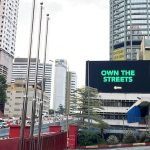By Mark Tungate
To prevent onlookers from getting in the way of rescue workers at emergency sites, Scholz & Friends created a new kind of highway code. Creative directors Ramona Junggeburth and Christoph Schlossnikel tell us how it came about.
If you take the highway fairly regularly, you’ll have noticed the phenomenon of traffic jams caused by motorists slowing down to look at accidents. In some cases, passers-by shoot images with their phones, even leaving their cars to do so.
This kind of “rubbernecking” can obstruct emergency workers and aggravate an already perilous situation for accident victims.
Scholz & Friends came up with a solution: a camouflaged QR code on the side of emergency vehicles which, when detected by phones, automatically warns the curious to back off. “Stop! Gawking kills! You are impending rescue workers and are liable to prosecution.”
QR codes have become familiar – but very few of them save lives. The Epica Awards jury felt the innovation merited a hard-fought Responsibility Grand Prix.
How did the idea first emerge? Were you already working with the client at that point?
RJ & CS: When the idea was born, we as an agency had been working for our client Johanniter (the German first aid and ambulance service) for more than a year and had already completed the corporate design relaunch. I
n a meeting, we casually learned that onlookers taking photos with smartphones are a big problem for rescue operations.
It was clear to us that another educational campaign simply wouldn’t do the job. So the real creative challenge was to find a clever technique, how to catch onlookers in the very moment of their wrong-doing.
We thought about QR codes very soon. The beauty of this technique is that the onlookers’ camera recognises the QR code automatically and drops the warning URL.
But the problem was: an obvious QR code would have only encouraged people to scan it with their smartphone.
The breakthrough was the idea of designing a hidden QR code that doesn’t look like one, more like a camouflage pattern. So that it looks like a design element of the rescue vehicles or uniforms. A QR-Code “in disguise”, that catches people by surprise.
How long did it take to put the operation in place? It must have taken some time to apply the markings to the emergency vehicles?
The time span between the first presentation of the idea to the client and the first prototype ambulance vehicle on the road was only three months. The legal requirements for the design of emergency vehicles in Germany are different in each federal state.
We decided to test the design in Berlin and Brandenburg, where the design was easily compatible with the legal requirements.
How did you launch the project via the media? I understand that there was an important social media element to the campaign?
The main focus was on Johanniter’s social media channels. There we presented the concept with several videos.
Accompanied by interviews and statements from rescue workers and experts such as lawyers. The story was then quickly covered by the traditional media.

What was the initial reaction from the public?
We were overwhelmed by the public reaction. If anything, we had only expected reactions from experts or other rescue organisations. But the discussion, on social media in particular, has shown us that the topic is very emotional for people.
We can tell you: As creatives, working in advertising, it’s unusual to get so much positive and emotional feedback.
After all it’s not every day that your work even gets applauded by the German chancellor. And, even more importantly, by so many rescue forces that feel supported in their everyday work.
So finally it’s not just work from advertisers for advertisers but has real-life impact, which is really nice.
Do you have any figures on how the campaign has positively impacted the work of the emergency services?
Right now the design is in a scientific test phase. We expect the final results this fall – but the first interim results look very promising. If the effectiveness of the concept is confirmed, it will be used on all Johanniter rescue vehicles in the future.
What are the prospects for a European or even international roll-out of this service?
Once the effectiveness is scientifically proven, Johanniter is open to sharing the design with other rescue organisations. There is already interest from rescue organisations in Europe, but also from the USA or Dubai. Seeing rescue vehicles with the QR-design in other countries would make us very happy and proud.
MARKETING Magazine is not responsible for the content of external sites.










